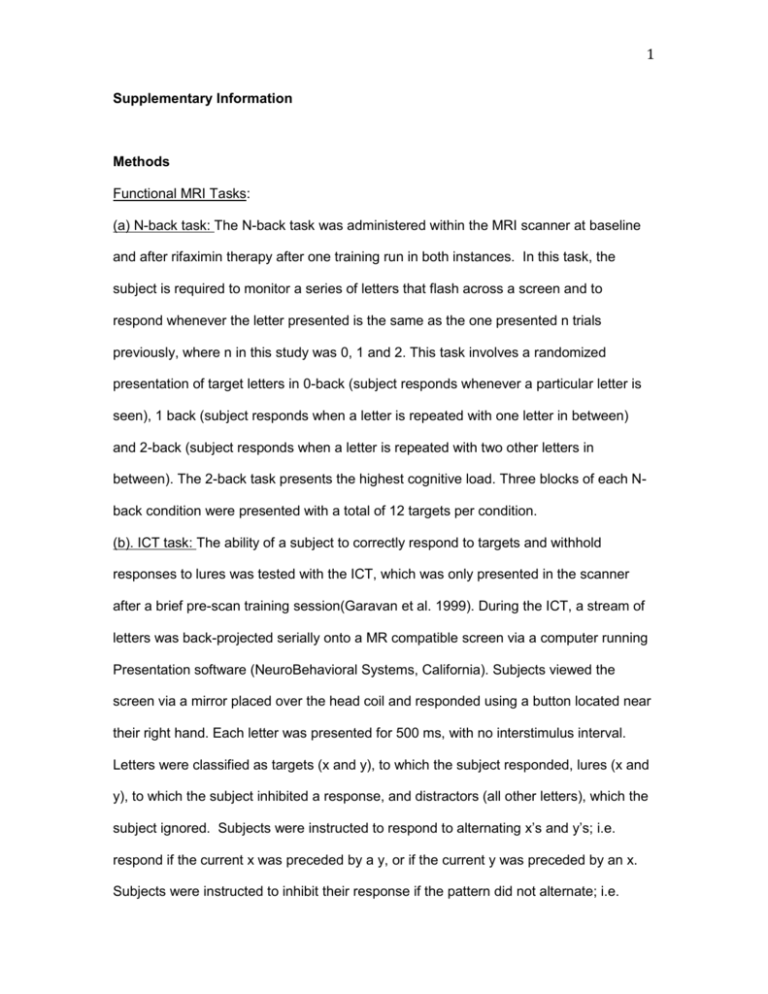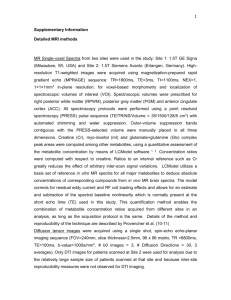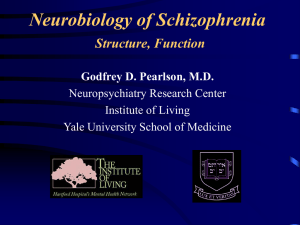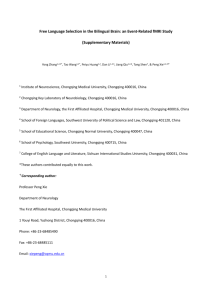Supplementary Information Methods Functional MRI Tasks: (a) N
advertisement

1 Supplementary Information Methods Functional MRI Tasks: (a) N-back task: The N-back task was administered within the MRI scanner at baseline and after rifaximin therapy after one training run in both instances. In this task, the subject is required to monitor a series of letters that flash across a screen and to respond whenever the letter presented is the same as the one presented n trials previously, where n in this study was 0, 1 and 2. This task involves a randomized presentation of target letters in 0-back (subject responds whenever a particular letter is seen), 1 back (subject responds when a letter is repeated with one letter in between) and 2-back (subject responds when a letter is repeated with two other letters in between). The 2-back task presents the highest cognitive load. Three blocks of each Nback condition were presented with a total of 12 targets per condition. (b). ICT task: The ability of a subject to correctly respond to targets and withhold responses to lures was tested with the ICT, which was only presented in the scanner after a brief pre-scan training session(Garavan et al. 1999). During the ICT, a stream of letters was back-projected serially onto a MR compatible screen via a computer running Presentation software (NeuroBehavioral Systems, California). Subjects viewed the screen via a mirror placed over the head coil and responded using a button located near their right hand. Each letter was presented for 500 ms, with no interstimulus interval. Letters were classified as targets (x and y), to which the subject responded, lures (x and y), to which the subject inhibited a response, and distractors (all other letters), which the subject ignored. Subjects were instructed to respond to alternating x’s and y’s; i.e. respond if the current x was preceded by a y, or if the current y was preceded by an x. Subjects were instructed to inhibit their response if the pattern did not alternate; i.e. 2 inhibit if the current x was preceded by an x, or if the current y was preceded by a y. On average, targets were presented every 3.5 sec and lures every 20 sec. A minimum of 15 sec separated consecutive lures. For the entire experiment, there were 212 targets, 40 lures, and 1248 distractors presented. Response prepotency was maintained by including many more targets than lures and by instructing subjects to respond quickly. The ICT is well suited to the scanner environment in which subjects view a simple visual stimulus and respond with a single button press. fMRI Acquisition: All images were acquired on a 3T GE Signa (Milwaukee, WI) scanner using a quadrature birdcage RF head coil. BOLD images for both ICT and n-back tasks were acquired using a gradient echo, echo-planar pulse sequence (TE=30ms; TR=2000ms, FOV=240mm; 64 x 64 matrix; 3.75mm x 3.75mm in-plane resolution, Slice Thickness=4mm). Slices were prescribed 30 degrees to the AC-PC line to reduce susceptibility induced signal dropouts in the orbitofrontal areas of the brain (Deichmann 2003). Six runs of 83 volumes each were acquired for ICT and a single run of 272 volumes was acquired for the N-back task. A vacuum pillow was used to minimize head motion. The task stimuli were back-projected onto a MR compatible screen. The screen was viewed by a mirror on top of the head-coil. The task was delivered using Presentation software (NeuroBehavioral Systems, California). Subjects viewed the letters presented on a screen while lying down in the fMRI scanner through prism glasses and responded using a button located near their right hand. A high resolution structural brain image was acquired using a SPGR sequence (TE=3.2ms, TR =8.2ms, TI=450ms, Slice thickness =1.2mm, FOV=240mm, 256 x 192 matrix) for anatomical localization and registration of functional images. 3 fMRI data analysis: fMRI data analysis for both tasks was carried out using FEAT (FMRI Expert Analysis Tool) v 5.98 part of FSL (FMRIB’s Software Library, www.fmrib.ox.ac.uk/fsl) (Jenkinson et al. 2002; Smith 2002; Woolrich et al. 2001a). The following pre-statistics processing was applied; motion correction using MCFLIRT, nonbrain removal using BET spatial smoothing using a Gaussian kernel of FWHM 6.0mm; grand-mean intensity normalization of the entire 4D dataset by a single multiplicative factor; highpass temporal filtering (Gaussian-weighted least-squares straight line fitting, with sigma=50.0s for ICT data and 128s for nback data). Subjects that showed >1.5mm absolute motion were removed from further analysis. After preprocessing, a time-series statistical analysis was carried out using FILM with local autocorrelation correction. ICT analysis: First level time series statistical analysis was carried out on each of the six ICT runs separately. Stimulus timings for Correct Response to Target , Correct Inhibition to Lures (CIL), Incorrect Response to Lures were extracted from each individual response file recorded by the Presentation software. Regressors were created by convolving these events by three basis functions generated from FLOBS(Woolrich et al. 2004). This method avoids making a priori assumptions regarding the shape, delay or magnitude of the hemodynamic response function. A general linear model was specified that included CRT, CIL and INCRL as regressors of interest and motion parameters as confound regressors. Contrast maps were created for each basis function for each condition vs. Baseline (Fixation + Non-Target letters) and registered to high-resolution structural and the 152 brain average Montreal Neurological Institute (MNI) standard space template using linear (FLIRT) and nonlinear (FNIRT) registration methods(Jenkinson et al. 2002; Jenkinson and Smith 2001). Only the contrast image for the canonical basis function (first of the three basis functions) for CIL, CRT and INCRL was passed on to the higher-level analysis. Higher-level analysis was performed in two steps. The first step combined the 6 runs at the subject level using a standard weighted 4 fixed effects model to form a single statistic image for the CIL condition per subject. A paired group comparison was done at the second level to investigate brain areas with significant changes in activation to correct inhibition following Rifaximin treatment. This was done using FLAME (FMRIB's Local Analysis of Mixed Effects) stage 1(Beckmann et al. 2003; Woolrich 2008). Pre>Post-Rifaximin and Post>Pre-Rifaximin contrasts were generated and thresholded using a cluster-based threshold(Woolrich et al. 2001b). N-back analysis: Regressors were created for 0-back, 1-back and 2-back conditions and convolved with a gamma-variate hemodynamic response function and a multiple linear regression analysis was performed that also included motion parameters and motion outlier volumes(Jenkinson and Smith 2001) within the model. Contrast maps (1-back – 0-back) and (2-back – 0-back) were created to highlight the brain areas involved in working memory and registered to standard space using the same method as described above. Higher-level analysis involved a paired group comparison conducted using FLAME stage 1 and Pre>Post-Rifaximin and Post>Pre-Rifaximin contrasts were generated and thresholded using a cluster-based threshold. We also performed psychophysiological Interaction Analysis (PPI) for N-back to investigate whether there is a change in coupling or effective connectivity between a seed region in the working memory network and any other areas between the pre-rifaximin and post-rifaximin states. We defined seed regions within the working memory network based on the overlap of group mean activation voxels in pre- and post-rifaximin conditions. Spherical ROIs of 8mm radius were drawn bilaterally in the Inferior Frontal Gyrus (IFG) and the Precentral Gyrus. We setup four separate GLM analyses; for each ROI per rifaximin state. The first regressor in the GLM analysis represented the working memory load (2back-0back), second regressor represented the mean time series from the seed ROIs and third regressor represented the PPI. We computed paired-group difference maps 5 between pre- and post-rifaximin states using FLAME stage1 and a cluster-based threshold(Friston et al. 1997; Rogers et al. 2007). DTI and MRS acquisition Diffusion-weighted volumes were acquired using a single shot, spin-echo echo-planar imaging sequence (FOV=240mm, slice thickness=2.5mm, 96 x 96 matrix, TR =6000ms, TE=77.5ms, b-value=1000s/mm2, # b0 images = 4, # Diffusion Directions = 60). Highresolution T1-weighted images were reformatted in three planes and were used for localization of spectroscopic volumes of interest (VOI). Spectroscopic volumes were prescribed for Right Posterior White Matter (RPWM), Posterior Gray Matter (PGM) and Anterior Cingulate Cortex (ACC). Spectra were acquired in the three areas using PROBE (TE/TR/NS/Volume = 35/1500/128/8 cm3) with automated shimming and water suppression. Outer-volume suppression bands contiguous with the selected volume were manually placed in all three dimensions. DTI analysis: Diffusion images were corrected for eddy current related distortions and simple head motion using affine registration to a reference volume. Fractional Anisotropy (FA) and Mean Diffusivity (MD) maps were computed using the diffusion Toolbox in FSL. These maps were then transformed to standard space using a combination of nonlinear and affine registration tools. Twelve a priori ROIs for major white matter tracts were created using the DTI-based probabilistic white matter atlases using a probability threshold of 40%: frontal white matter (FWM), anterior internal capsule (AIC), posterior internal capsule (PIC), external capsule (EC), posterior white matter (PWM), uncinate fasciculus 6 (UF), inferior longitudinal fasciculus (ILF), superior longitudinal fasciculus (SLF), Cingulum (Cing) and three sub-regions of the corpus callosum; genu (CC_Genu), body (CC_body) and splenium (CC_Splen). Mean FA and MD values were extracted from individual maps(Wakana et al. 2007; Hua et al. 2008). Spectroscopy analysis: The choline (Cho), creatine (Cr), myo-inositol (mI) and glutamate+glutamine (Glx) complex peak areas were computed using a quantitative assessment of the metabolite concentration by means of LCModel software (Provencher 1993, 2001). These metabolites were chosen because of prior HE research showing changes in these metabolites(Sarma et al. 2011). Concentration ratios were computed with respect to creatine concentration. LCModel utilizes a basis set of reference in vitro MR spectra for all major metabolites to deduce absolute concentrations of corresponding compounds from in vivo MR brain spectra. The model corrects for residual eddy current and RF coil loading effects and allows for an estimate and subtraction of the spectral baseline nonlinearity which is normally present at the short TE used in this study (Provencher 1993, 2001). 7 Supplementary Table 1: Cognitive performance at pre-baseline compared to baseline Cognitive tests Number connection-A (seconds) Number connection-B (seconds) Digit symbol (raw score) Block design (raw score) Line tracing time (seconds) Line tracing errors (number) Serial dotting (seconds) ICT median responses Lures responded to (n/% CIL) Targets (% correct) Pre-baseline 43.2±20.4 100.2±23.4 48.6±10.4 24.3±9.6 119.5±29.3 44.6±25.3 70.2±23.5 Baseline 42.3±13.4 97.2±31.9 50.0±12.3 25.9±11.9 121.7±32.1 41.2±28.3 69.6±25.7 19 / 53% 97.2% 18 / 56% 96.50% There was no significant learning on cognitive tests at pre-baseline (2.0±0.9 months prior) compared to the baseline visit on paired t-tests. 8 Supplementary table 2: Localization and Z-scores of the main effect of working memory and ICT Correct Inhibition to Lures condition in MHE patients at baseline. 2-BACK Z-score 5.3 4.83 4.74 4.58 4.34 4.29 4.25 4.21 4.13 4.12 4.01 3.74 3.71 3.58 3.17 Localization L Precentral Gyrus Paracingulate Gyrus R Post Supramarginal Gyrus R Middle Frontal Gyrus L Frontal Pole Supplementary Motor Area R Angular Gyrus L Middle Frontal Gyrus R Frontal Orbital Cortex R Inferior Frontal Gyrus R Sup. Lateral Occipital Cortex R Frontal Pole R Insular Cortex R Occipital Fusiform Gyrus L Post. Supramarginal Gyrus MNI (x,y,z) mm -38, -4,36 ICT correct inhibition to lures MNI (x,y,z) Z-score Localization mm Paracingulate 6.18 8, 18, 40 Gyrus 0,22,38 6.03 R Frontal Pole 40, 52, 12 48, -40,40 5.79 Juxtapositional Lobule (SMA) -4, 8, 52 38,6,34 5.44 -48,38,14 5.44 -4,8,52 5.43 40, -50,30 5.41 -38,22,30 7.05 48,20, -6 5.93 50,20, -2 5.83 28, -58,42 5.42 36,36,12 4.78 36,24, -2 4.17 -28, -80, 16 3.9 -40, -48,36 5.42 R Middle Frontal Gyrus L Supramarginal Gyrus,Posterior L Superior Parietal Lobule L Angular Gyrus R Supramarginal Gyrus, Posterior R Angular Gyrus L Middle Frontal Gyrus L Frontal Pole L Precuneous Cortex R Precuneous Cortex Cingulate Gyrus, Posterior L Insular Cortex 38, 14, 42 -40, -48, 38 -30, -58, 40 -44, -52, 42 48, -40, 40 38, -48, 36 -42, 28, 26 -40, 52, 0 -8, -60, 12 14, -60, 18 0, -46, 30 -30, 18, 0 9 Supplementary Table 3: Mean Diffusivity (x10-3 mm2/s) in pre and post-rifaximin states ROIs FWM_L EC_L ILF_R ILF_L Cing_L Pre 0.875±0.056 0.828±0.040 0.861±0.044 0.845±0.051 0.826±0.055 Post 0.865±0.039 0.828±0.040 0.858±0.046 0.844±0.065 0.810±0.037 p-value 0.247 0.279 0.347 0.463 0.154 Left Frontal White Matter (FWM_L), Left External Capsule (EC_L), Right and Left Inferior Longitudinal Fasciculus (ILF_R, ILF_L), Left Cingulum (Cing_L) 10 Supplementary table 4 Pre- and Post-Rifaximin metabolite concentration ratios within three brain voxels, RPWM, PGM and ACC, calculated from LCModel analysis of 1HMRS. Choline/Cr Pre Post 0.317±0.08 0.313±0.06 Myoinositol/Cr Pre Post 0.645±0.33 0.66±0.35 Glutamate+Glutamine/Cr Pre Post 2.098±0.69 2.097±0.59 0.33 0.26 0.19 PGM p-value 0.208±0.05 0.201±0.03 0.25 0.609±0.22 0.601±0.20 0.37 2.103±0.67 ACC p-value 0.290±0.04 0.283±0.03 0.41 0.573±0.28 0.606±0.19 0.12 2.342±0.61 RPWM p-value 2.020±0.32 0.21 2.322±0.50 0.3 RPWM: right parietal white matter, PGM: posterior/occipital gray matter, ACC: anterior cingulate cortex 11 Supplementary Figure 1: (A) Main effect of working memory task. (B) Main Effect of Correct Inhibition to Lures; cluster-corrected Z=3.1, P<0.05 with a color scale (Z=3.1 to 4.5) representing Z-scores (Red-Yellow), R: right hemisphere. A B Supplementary References: Beckmann CF, Jenkinson M, Smith SM (2003) General multilevel linear modeling for group analysis in FMRI. NeuroImage 20 (2):1052-1063. doi:10.1016/s1053-8119(03)00435-x Friston KJ, Buechel C, Fink GR, Morris J, Rolls E, Dolan RJ (1997) Psychophysiological and modulatory interactions in neuroimaging. Neuroimage 6 (3):218-229. doi:S1053-8119(97)90291-3 [pii] 10.1006/nimg.1997.0291 Garavan H, Ross TJ, Stein EA (1999) Right hemispheric dominance of inhibitory control: an event-related functional MRI study. Proc Natl Acad Sci U S A 96 (14):8301-8306 12 Hua K, Zhang J, Wakana S, Jiang H, Li X, Reich DS, Calabresi PA, Pekar JJ, van Zijl PC, Mori S (2008) Tract probability maps in stereotaxic spaces: analyses of white matter anatomy and tract-specific quantification. Neuroimage 39 (1):336-347. doi:S1053-8119(07)00688-X [pii] 10.1016/j.neuroimage.2007.07.053 Jenkinson M, Bannister P, Brady M, Smith S (2002) Improved optimization for the robust and accurate linear registration and motion correction of brain images. NeuroImage 17 (1053-8119; 2):825-841 Jenkinson M, Smith S (2001) A global optimisation method for robust affine registration of brain images. Medical image analysis 5 (2):143-156 Provencher SW (1993) Estimation of metabolite concentrations from localized in vivo proton NMR spectra. Magn Reson Med 30 (6):672-679 Provencher SW (2001) Automatic quantitation of localized in vivo 1H spectra with LCModel. NMR Biomed 14 (4):260-264. doi:10.1002/nbm.698 [pii] Rogers BP, Morgan VL, Newton AT, Gore JC (2007) Assessing functional connectivity in the human brain by fMRI. Magn Reson Imaging 25 (10):1347-1357. doi:S0730-725X(07)00223-8 [pii] 10.1016/j.mri.2007.03.007 Sarma MK, Huda A, Nagarajan R, Hinkin CH, Wilson N, Gupta RK, FriasMartinez E, Sayre J, Guze B, Han SH, Thomas MA (2011) Multidimensional MR spectroscopy: towards a better understanding of hepatic encephalopathy. Metab Brain Dis 26 (3):173-184. doi:10.1007/s11011-011-9250-1 Smith SM (2002) Fast robust automated brain extraction. Human brain mapping 17 (3):143-155. doi:10.1002/hbm.10062 Wakana S, Caprihan A, Panzenboeck MM, Fallon JH, Perry M, Gollub RL, Hua K, Zhang J, Jiang H, Dubey P, Blitz A, van Zijl P, Mori S (2007) Reproducibility of quantitative tractography methods applied to cerebral white matter. Neuroimage 36 (3):630-644. doi:S10538119(07)00138-3 [pii] 10.1016/j.neuroimage.2007.02.049 Woolrich M (2008) Robust group analysis using outlier inference. NeuroImage 41 (2):286-301. doi:10.1016/j.neuroimage.2008.02.042; 10.1016/j.neuroimage.2008.02.042 Woolrich MW, Behrens TE, Beckmann CF, Jenkinson M, Smith SM (2004) Multilevel linear modelling for FMRI group analysis using Bayesian inference. NeuroImage 21 (1053-8119; 4):1732-1747 Woolrich MW, Ripley BD, Brady M, Smith SM (2001a) Temporal autocorrelation in univariate linear modeling of FMRI data. NeuroImage 14 (1053-8119; 6):1370-1386 Woolrich MW, Ripley BD, Brady M, Smith SM (2001b) Temporal autocorrelation in univariate linear modeling of FMRI data. NeuroImage 14 (6):1370-1386. doi:10.1006/nimg.2001.0931









